Finance Report: Corporate Governance, Value, Budgeting, and Compliance
VerifiedAdded on 2022/08/12
|10
|1531
|51
Report
AI Summary
This report delves into fundamental finance concepts, emphasizing the significance of corporate governance, compliance, and their impact on business objectives. It explores the processes of financial governance, including financial reporting, dealing with income, and record-keeping, while also assessing the implications of unresolved governance issues. The report then examines the concept of value for money, detailing how organizations can achieve it through efficient processes with suppliers and customers, and within teams/departments. Furthermore, it highlights the importance of realistic budgeting, contingency planning, and budget monitoring. The report concludes by underscoring the necessity of adhering to internal and external regulations and the role of effective planning, monitoring, and communication in achieving organizational goals and value for money. The provided references offer additional insights into the topics discussed.

Running head: FINANCE
Finance
Name of the Student
Name of the University
Author note
Finance
Name of the Student
Name of the University
Author note
Paraphrase This Document
Need a fresh take? Get an instant paraphrase of this document with our AI Paraphraser
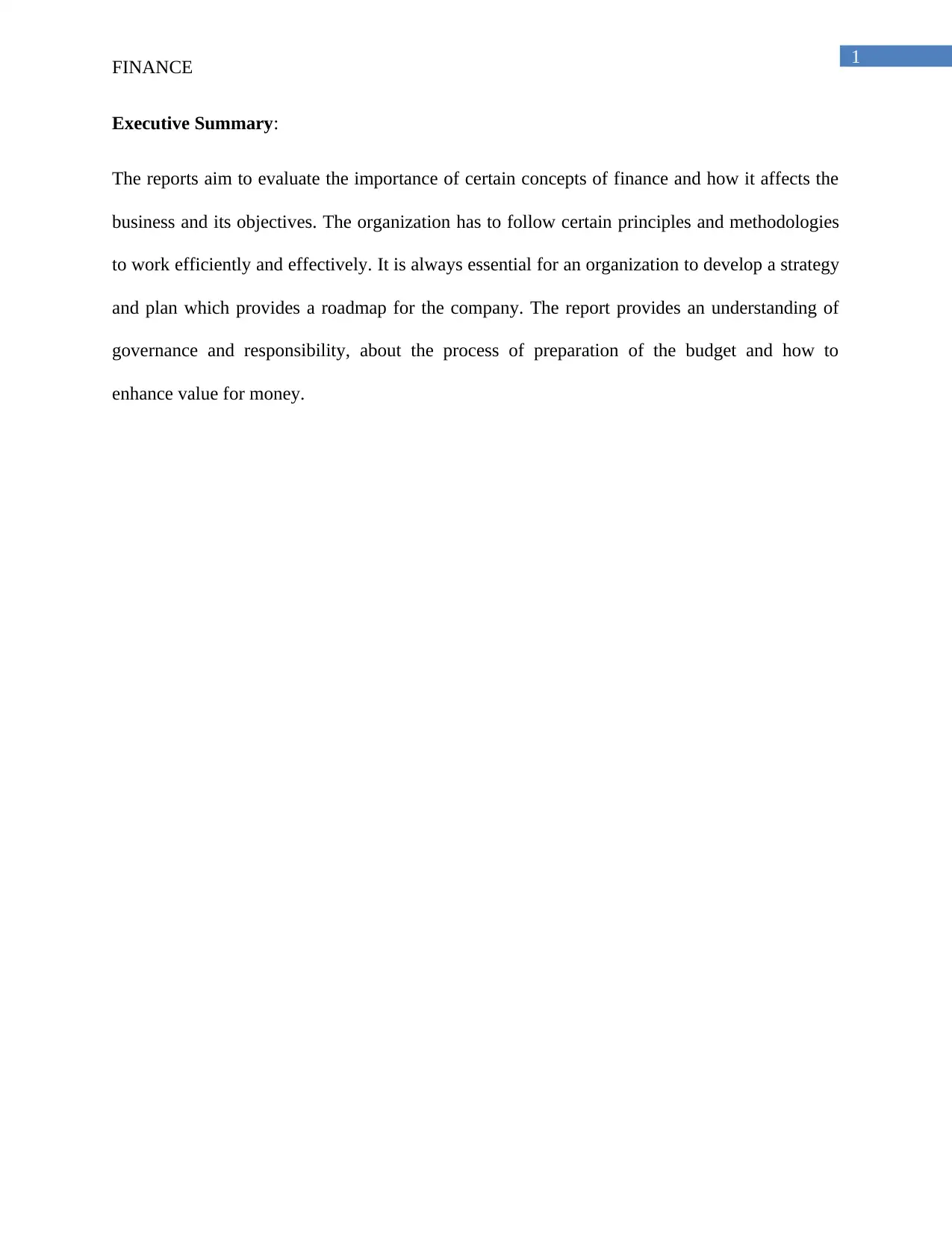
1
FINANCE
Executive Summary:
The reports aim to evaluate the importance of certain concepts of finance and how it affects the
business and its objectives. The organization has to follow certain principles and methodologies
to work efficiently and effectively. It is always essential for an organization to develop a strategy
and plan which provides a roadmap for the company. The report provides an understanding of
governance and responsibility, about the process of preparation of the budget and how to
enhance value for money.
FINANCE
Executive Summary:
The reports aim to evaluate the importance of certain concepts of finance and how it affects the
business and its objectives. The organization has to follow certain principles and methodologies
to work efficiently and effectively. It is always essential for an organization to develop a strategy
and plan which provides a roadmap for the company. The report provides an understanding of
governance and responsibility, about the process of preparation of the budget and how to
enhance value for money.
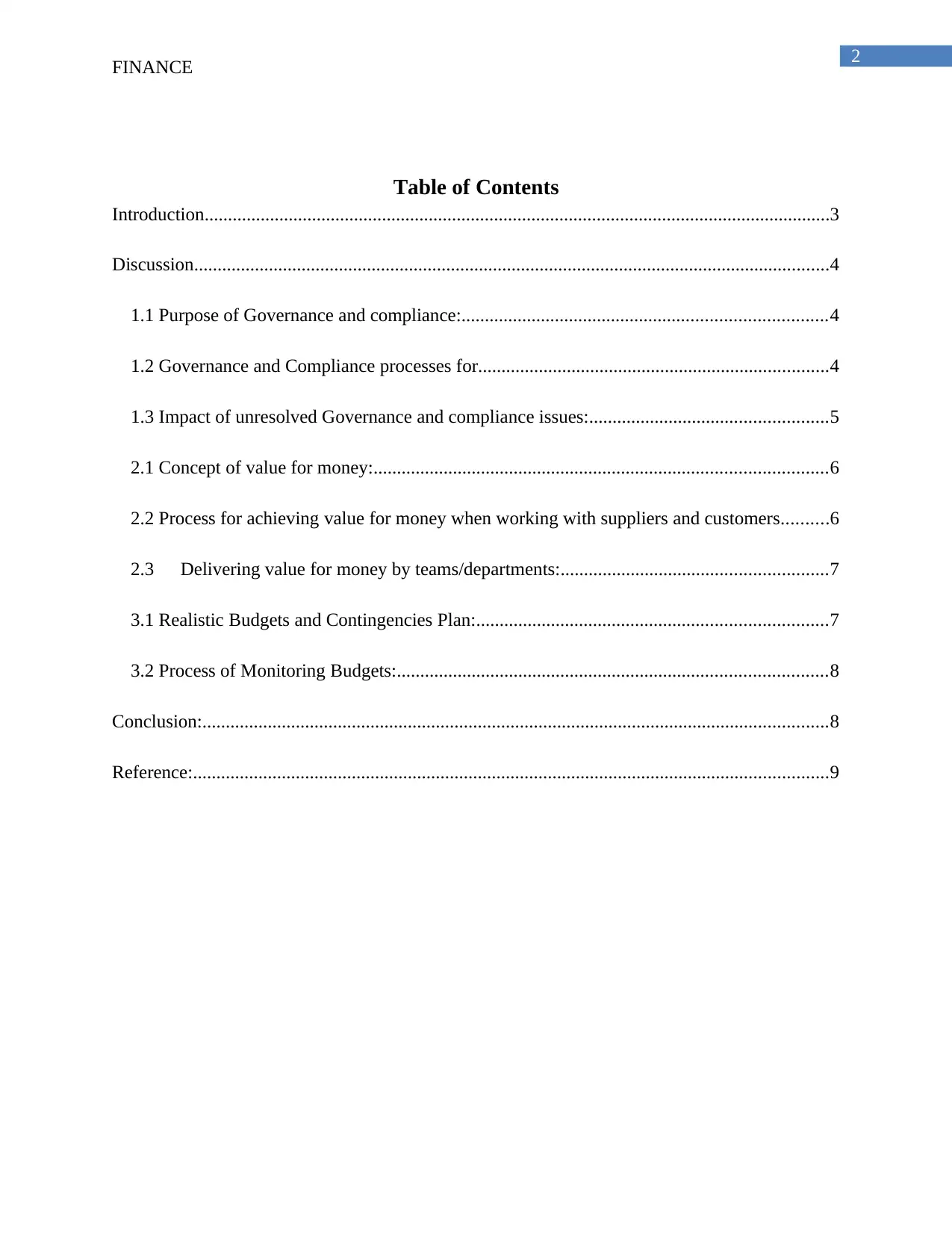
2
FINANCE
Table of Contents
Introduction......................................................................................................................................3
Discussion........................................................................................................................................4
1.1 Purpose of Governance and compliance:..............................................................................4
1.2 Governance and Compliance processes for...........................................................................4
1.3 Impact of unresolved Governance and compliance issues:...................................................5
2.1 Concept of value for money:.................................................................................................6
2.2 Process for achieving value for money when working with suppliers and customers..........6
2.3 Delivering value for money by teams/departments:.........................................................7
3.1 Realistic Budgets and Contingencies Plan:...........................................................................7
3.2 Process of Monitoring Budgets:............................................................................................8
Conclusion:......................................................................................................................................8
Reference:........................................................................................................................................9
FINANCE
Table of Contents
Introduction......................................................................................................................................3
Discussion........................................................................................................................................4
1.1 Purpose of Governance and compliance:..............................................................................4
1.2 Governance and Compliance processes for...........................................................................4
1.3 Impact of unresolved Governance and compliance issues:...................................................5
2.1 Concept of value for money:.................................................................................................6
2.2 Process for achieving value for money when working with suppliers and customers..........6
2.3 Delivering value for money by teams/departments:.........................................................7
3.1 Realistic Budgets and Contingencies Plan:...........................................................................7
3.2 Process of Monitoring Budgets:............................................................................................8
Conclusion:......................................................................................................................................8
Reference:........................................................................................................................................9
⊘ This is a preview!⊘
Do you want full access?
Subscribe today to unlock all pages.

Trusted by 1+ million students worldwide
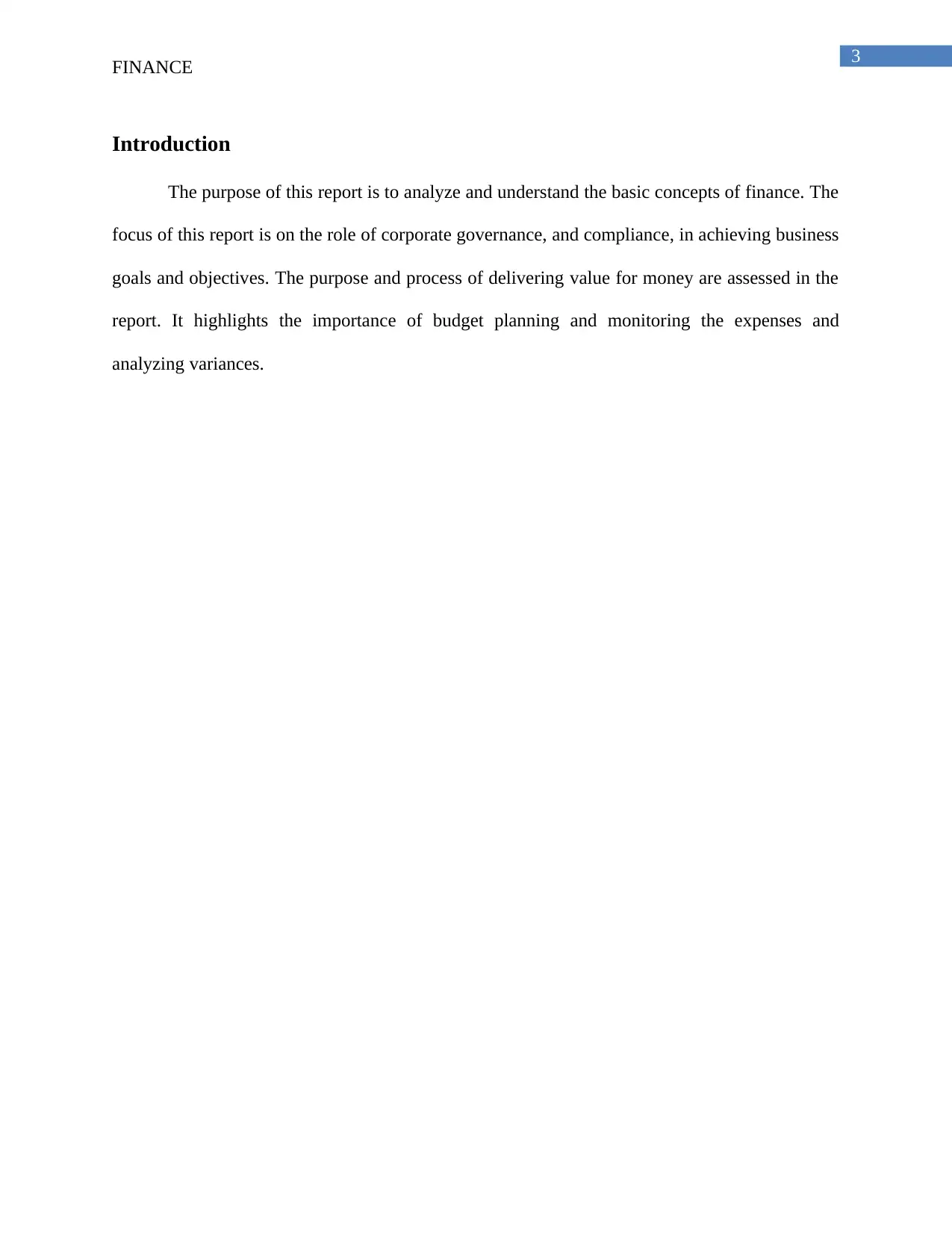
3
FINANCE
Introduction
The purpose of this report is to analyze and understand the basic concepts of finance. The
focus of this report is on the role of corporate governance, and compliance, in achieving business
goals and objectives. The purpose and process of delivering value for money are assessed in the
report. It highlights the importance of budget planning and monitoring the expenses and
analyzing variances.
FINANCE
Introduction
The purpose of this report is to analyze and understand the basic concepts of finance. The
focus of this report is on the role of corporate governance, and compliance, in achieving business
goals and objectives. The purpose and process of delivering value for money are assessed in the
report. It highlights the importance of budget planning and monitoring the expenses and
analyzing variances.
Paraphrase This Document
Need a fresh take? Get an instant paraphrase of this document with our AI Paraphraser
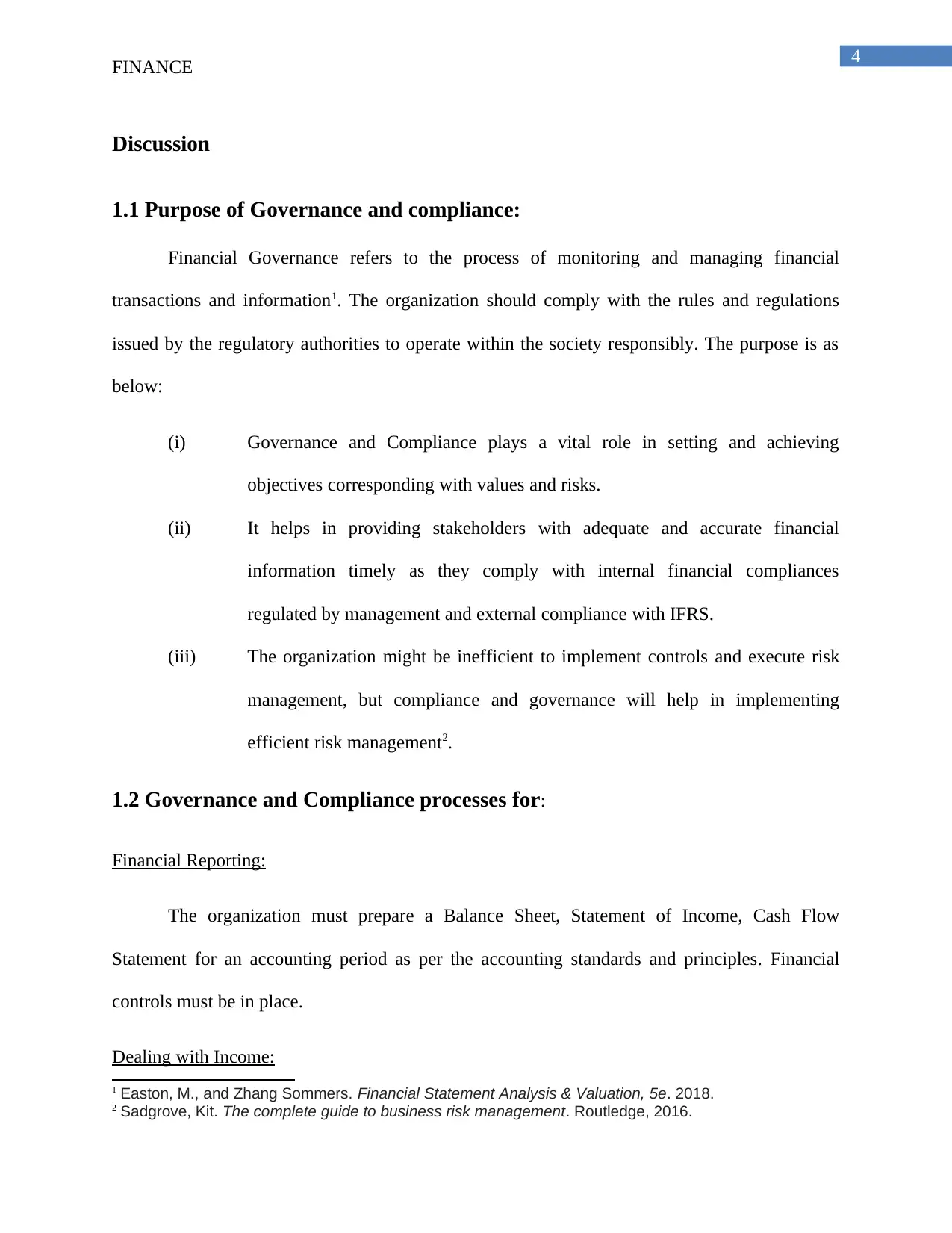
4
FINANCE
Discussion
1.1 Purpose of Governance and compliance:
Financial Governance refers to the process of monitoring and managing financial
transactions and information1. The organization should comply with the rules and regulations
issued by the regulatory authorities to operate within the society responsibly. The purpose is as
below:
(i) Governance and Compliance plays a vital role in setting and achieving
objectives corresponding with values and risks.
(ii) It helps in providing stakeholders with adequate and accurate financial
information timely as they comply with internal financial compliances
regulated by management and external compliance with IFRS.
(iii) The organization might be inefficient to implement controls and execute risk
management, but compliance and governance will help in implementing
efficient risk management2.
1.2 Governance and Compliance processes for:
Financial Reporting:
The organization must prepare a Balance Sheet, Statement of Income, Cash Flow
Statement for an accounting period as per the accounting standards and principles. Financial
controls must be in place.
Dealing with Income:
1 Easton, M., and Zhang Sommers. Financial Statement Analysis & Valuation, 5e. 2018.
2 Sadgrove, Kit. The complete guide to business risk management. Routledge, 2016.
FINANCE
Discussion
1.1 Purpose of Governance and compliance:
Financial Governance refers to the process of monitoring and managing financial
transactions and information1. The organization should comply with the rules and regulations
issued by the regulatory authorities to operate within the society responsibly. The purpose is as
below:
(i) Governance and Compliance plays a vital role in setting and achieving
objectives corresponding with values and risks.
(ii) It helps in providing stakeholders with adequate and accurate financial
information timely as they comply with internal financial compliances
regulated by management and external compliance with IFRS.
(iii) The organization might be inefficient to implement controls and execute risk
management, but compliance and governance will help in implementing
efficient risk management2.
1.2 Governance and Compliance processes for:
Financial Reporting:
The organization must prepare a Balance Sheet, Statement of Income, Cash Flow
Statement for an accounting period as per the accounting standards and principles. Financial
controls must be in place.
Dealing with Income:
1 Easton, M., and Zhang Sommers. Financial Statement Analysis & Valuation, 5e. 2018.
2 Sadgrove, Kit. The complete guide to business risk management. Routledge, 2016.
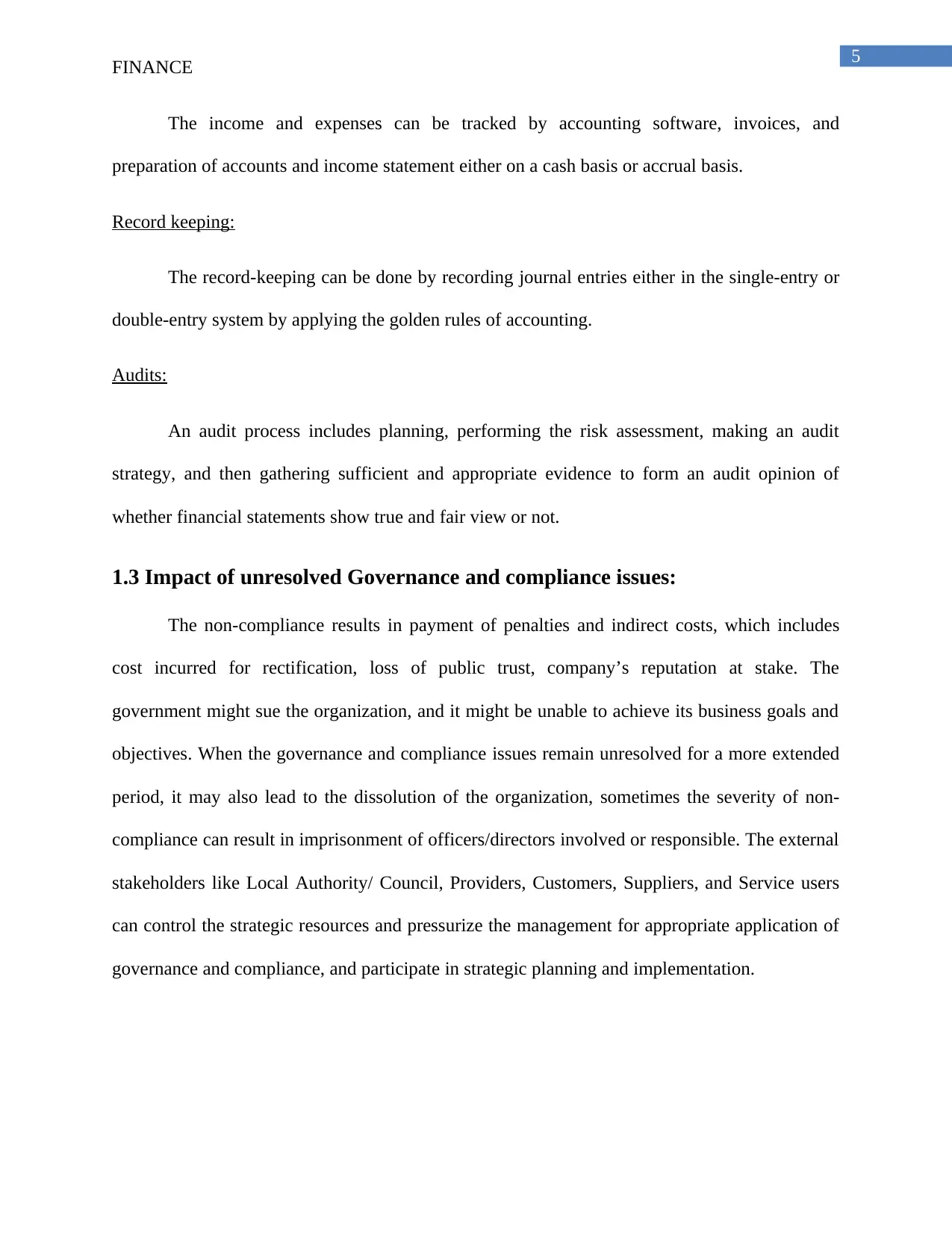
5
FINANCE
The income and expenses can be tracked by accounting software, invoices, and
preparation of accounts and income statement either on a cash basis or accrual basis.
Record keeping:
The record-keeping can be done by recording journal entries either in the single-entry or
double-entry system by applying the golden rules of accounting.
Audits:
An audit process includes planning, performing the risk assessment, making an audit
strategy, and then gathering sufficient and appropriate evidence to form an audit opinion of
whether financial statements show true and fair view or not.
1.3 Impact of unresolved Governance and compliance issues:
The non-compliance results in payment of penalties and indirect costs, which includes
cost incurred for rectification, loss of public trust, company’s reputation at stake. The
government might sue the organization, and it might be unable to achieve its business goals and
objectives. When the governance and compliance issues remain unresolved for a more extended
period, it may also lead to the dissolution of the organization, sometimes the severity of non-
compliance can result in imprisonment of officers/directors involved or responsible. The external
stakeholders like Local Authority/ Council, Providers, Customers, Suppliers, and Service users
can control the strategic resources and pressurize the management for appropriate application of
governance and compliance, and participate in strategic planning and implementation.
FINANCE
The income and expenses can be tracked by accounting software, invoices, and
preparation of accounts and income statement either on a cash basis or accrual basis.
Record keeping:
The record-keeping can be done by recording journal entries either in the single-entry or
double-entry system by applying the golden rules of accounting.
Audits:
An audit process includes planning, performing the risk assessment, making an audit
strategy, and then gathering sufficient and appropriate evidence to form an audit opinion of
whether financial statements show true and fair view or not.
1.3 Impact of unresolved Governance and compliance issues:
The non-compliance results in payment of penalties and indirect costs, which includes
cost incurred for rectification, loss of public trust, company’s reputation at stake. The
government might sue the organization, and it might be unable to achieve its business goals and
objectives. When the governance and compliance issues remain unresolved for a more extended
period, it may also lead to the dissolution of the organization, sometimes the severity of non-
compliance can result in imprisonment of officers/directors involved or responsible. The external
stakeholders like Local Authority/ Council, Providers, Customers, Suppliers, and Service users
can control the strategic resources and pressurize the management for appropriate application of
governance and compliance, and participate in strategic planning and implementation.
⊘ This is a preview!⊘
Do you want full access?
Subscribe today to unlock all pages.

Trusted by 1+ million students worldwide
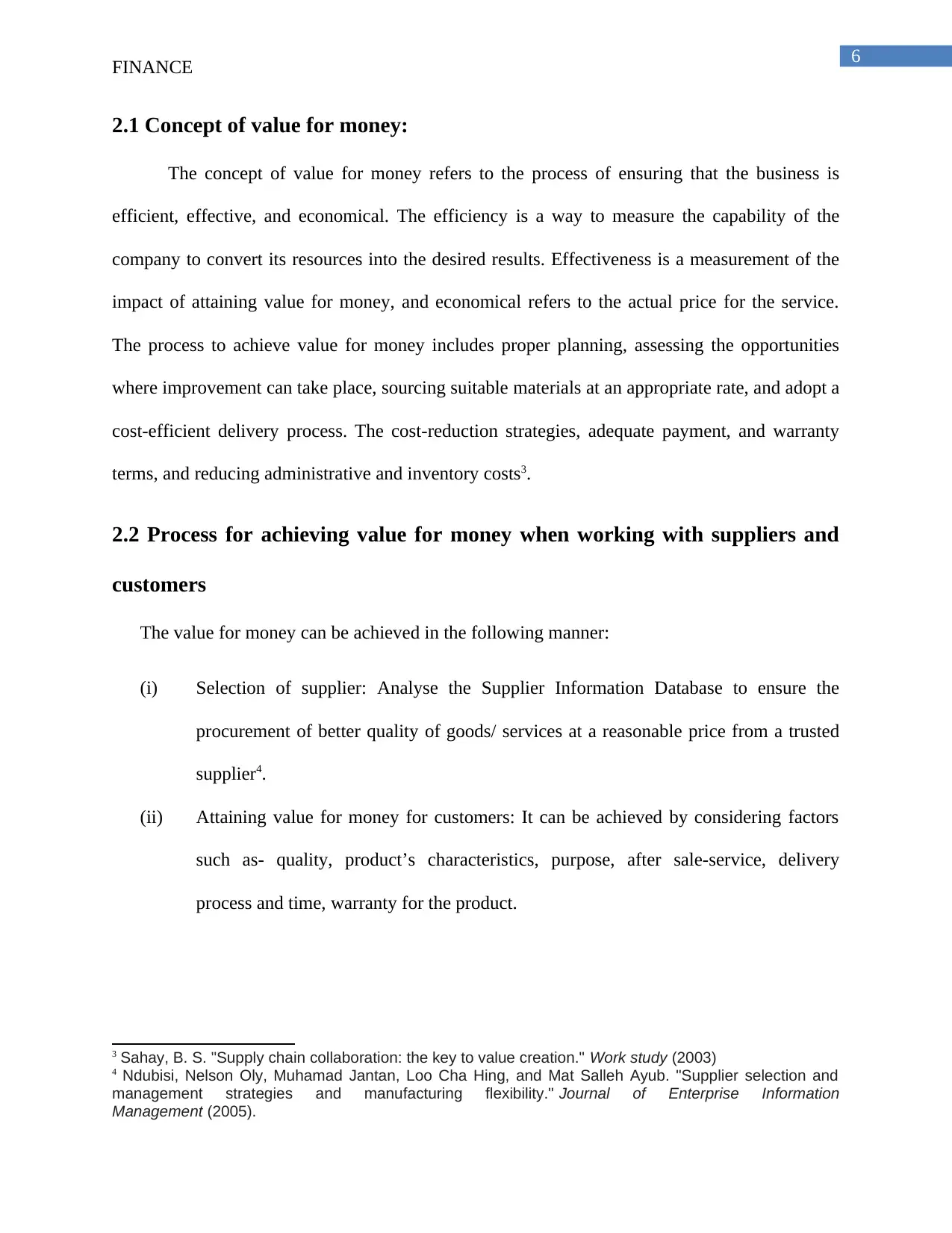
6
FINANCE
2.1 Concept of value for money:
The concept of value for money refers to the process of ensuring that the business is
efficient, effective, and economical. The efficiency is a way to measure the capability of the
company to convert its resources into the desired results. Effectiveness is a measurement of the
impact of attaining value for money, and economical refers to the actual price for the service.
The process to achieve value for money includes proper planning, assessing the opportunities
where improvement can take place, sourcing suitable materials at an appropriate rate, and adopt a
cost-efficient delivery process. The cost-reduction strategies, adequate payment, and warranty
terms, and reducing administrative and inventory costs3.
2.2 Process for achieving value for money when working with suppliers and
customers
The value for money can be achieved in the following manner:
(i) Selection of supplier: Analyse the Supplier Information Database to ensure the
procurement of better quality of goods/ services at a reasonable price from a trusted
supplier4.
(ii) Attaining value for money for customers: It can be achieved by considering factors
such as- quality, product’s characteristics, purpose, after sale-service, delivery
process and time, warranty for the product.
3 Sahay, B. S. "Supply chain collaboration: the key to value creation." Work study (2003)
4 Ndubisi, Nelson Oly, Muhamad Jantan, Loo Cha Hing, and Mat Salleh Ayub. "Supplier selection and
management strategies and manufacturing flexibility." Journal of Enterprise Information
Management (2005).
FINANCE
2.1 Concept of value for money:
The concept of value for money refers to the process of ensuring that the business is
efficient, effective, and economical. The efficiency is a way to measure the capability of the
company to convert its resources into the desired results. Effectiveness is a measurement of the
impact of attaining value for money, and economical refers to the actual price for the service.
The process to achieve value for money includes proper planning, assessing the opportunities
where improvement can take place, sourcing suitable materials at an appropriate rate, and adopt a
cost-efficient delivery process. The cost-reduction strategies, adequate payment, and warranty
terms, and reducing administrative and inventory costs3.
2.2 Process for achieving value for money when working with suppliers and
customers
The value for money can be achieved in the following manner:
(i) Selection of supplier: Analyse the Supplier Information Database to ensure the
procurement of better quality of goods/ services at a reasonable price from a trusted
supplier4.
(ii) Attaining value for money for customers: It can be achieved by considering factors
such as- quality, product’s characteristics, purpose, after sale-service, delivery
process and time, warranty for the product.
3 Sahay, B. S. "Supply chain collaboration: the key to value creation." Work study (2003)
4 Ndubisi, Nelson Oly, Muhamad Jantan, Loo Cha Hing, and Mat Salleh Ayub. "Supplier selection and
management strategies and manufacturing flexibility." Journal of Enterprise Information
Management (2005).
Paraphrase This Document
Need a fresh take? Get an instant paraphrase of this document with our AI Paraphraser
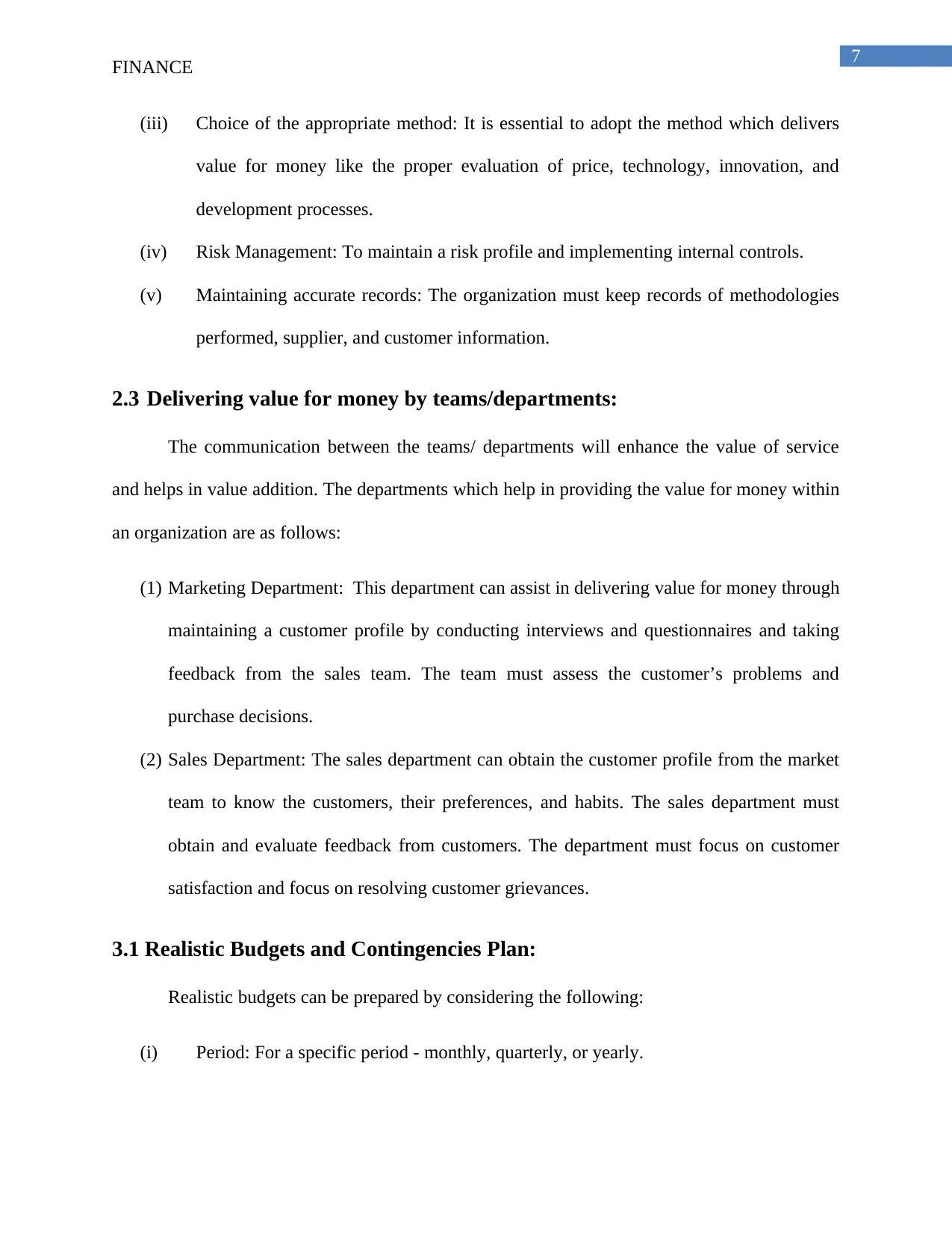
7
FINANCE
(iii) Choice of the appropriate method: It is essential to adopt the method which delivers
value for money like the proper evaluation of price, technology, innovation, and
development processes.
(iv) Risk Management: To maintain a risk profile and implementing internal controls.
(v) Maintaining accurate records: The organization must keep records of methodologies
performed, supplier, and customer information.
2.3 Delivering value for money by teams/departments:
The communication between the teams/ departments will enhance the value of service
and helps in value addition. The departments which help in providing the value for money within
an organization are as follows:
(1) Marketing Department: This department can assist in delivering value for money through
maintaining a customer profile by conducting interviews and questionnaires and taking
feedback from the sales team. The team must assess the customer’s problems and
purchase decisions.
(2) Sales Department: The sales department can obtain the customer profile from the market
team to know the customers, their preferences, and habits. The sales department must
obtain and evaluate feedback from customers. The department must focus on customer
satisfaction and focus on resolving customer grievances.
3.1 Realistic Budgets and Contingencies Plan:
Realistic budgets can be prepared by considering the following:
(i) Period: For a specific period - monthly, quarterly, or yearly.
FINANCE
(iii) Choice of the appropriate method: It is essential to adopt the method which delivers
value for money like the proper evaluation of price, technology, innovation, and
development processes.
(iv) Risk Management: To maintain a risk profile and implementing internal controls.
(v) Maintaining accurate records: The organization must keep records of methodologies
performed, supplier, and customer information.
2.3 Delivering value for money by teams/departments:
The communication between the teams/ departments will enhance the value of service
and helps in value addition. The departments which help in providing the value for money within
an organization are as follows:
(1) Marketing Department: This department can assist in delivering value for money through
maintaining a customer profile by conducting interviews and questionnaires and taking
feedback from the sales team. The team must assess the customer’s problems and
purchase decisions.
(2) Sales Department: The sales department can obtain the customer profile from the market
team to know the customers, their preferences, and habits. The sales department must
obtain and evaluate feedback from customers. The department must focus on customer
satisfaction and focus on resolving customer grievances.
3.1 Realistic Budgets and Contingencies Plan:
Realistic budgets can be prepared by considering the following:
(i) Period: For a specific period - monthly, quarterly, or yearly.
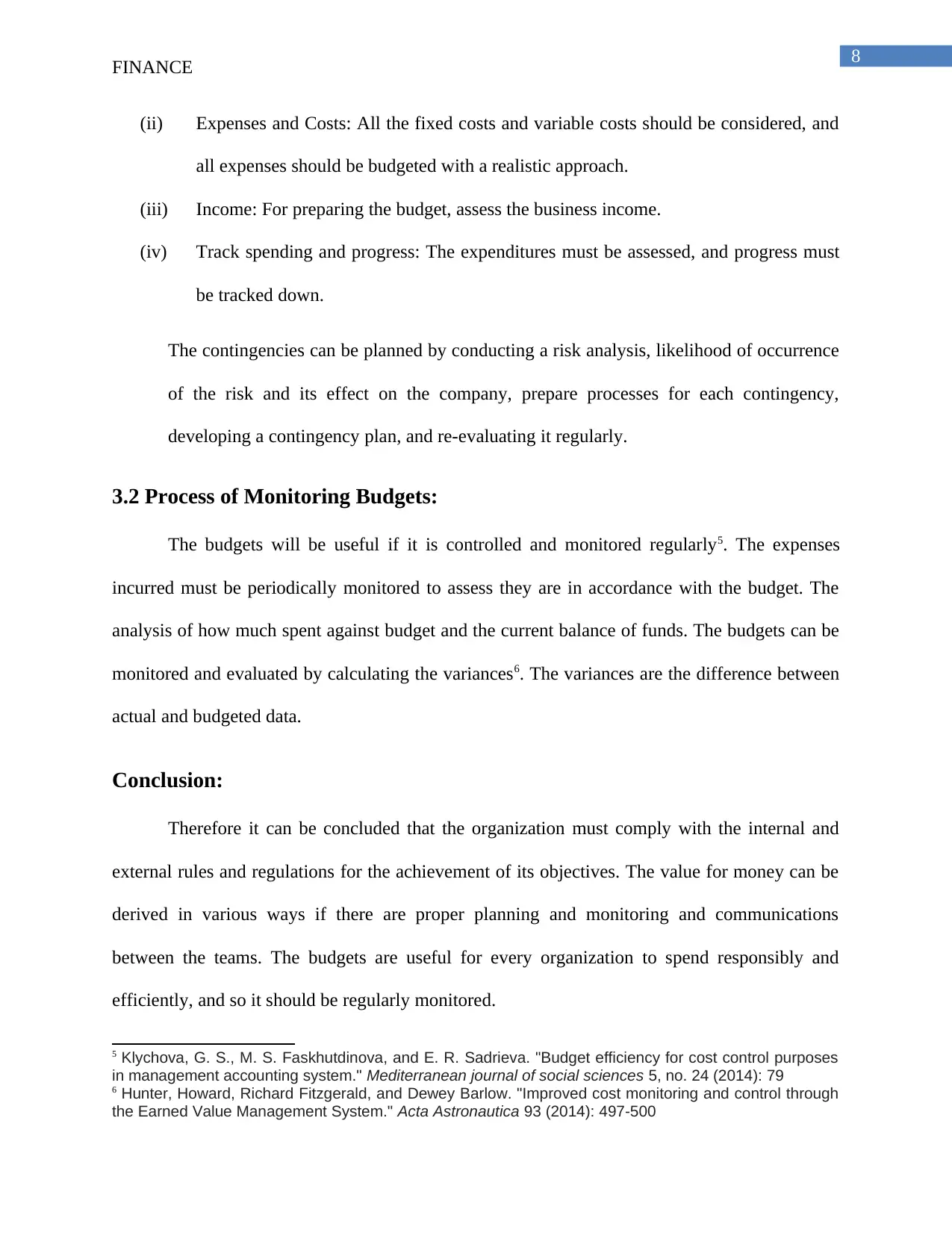
8
FINANCE
(ii) Expenses and Costs: All the fixed costs and variable costs should be considered, and
all expenses should be budgeted with a realistic approach.
(iii) Income: For preparing the budget, assess the business income.
(iv) Track spending and progress: The expenditures must be assessed, and progress must
be tracked down.
The contingencies can be planned by conducting a risk analysis, likelihood of occurrence
of the risk and its effect on the company, prepare processes for each contingency,
developing a contingency plan, and re-evaluating it regularly.
3.2 Process of Monitoring Budgets:
The budgets will be useful if it is controlled and monitored regularly5. The expenses
incurred must be periodically monitored to assess they are in accordance with the budget. The
analysis of how much spent against budget and the current balance of funds. The budgets can be
monitored and evaluated by calculating the variances6. The variances are the difference between
actual and budgeted data.
Conclusion:
Therefore it can be concluded that the organization must comply with the internal and
external rules and regulations for the achievement of its objectives. The value for money can be
derived in various ways if there are proper planning and monitoring and communications
between the teams. The budgets are useful for every organization to spend responsibly and
efficiently, and so it should be regularly monitored.
5 Klychova, G. S., М. S. Faskhutdinova, and E. R. Sadrieva. "Budget efficiency for cost control purposes
in management accounting system." Mediterranean journal of social sciences 5, no. 24 (2014): 79
6 Hunter, Howard, Richard Fitzgerald, and Dewey Barlow. "Improved cost monitoring and control through
the Earned Value Management System." Acta Astronautica 93 (2014): 497-500
FINANCE
(ii) Expenses and Costs: All the fixed costs and variable costs should be considered, and
all expenses should be budgeted with a realistic approach.
(iii) Income: For preparing the budget, assess the business income.
(iv) Track spending and progress: The expenditures must be assessed, and progress must
be tracked down.
The contingencies can be planned by conducting a risk analysis, likelihood of occurrence
of the risk and its effect on the company, prepare processes for each contingency,
developing a contingency plan, and re-evaluating it regularly.
3.2 Process of Monitoring Budgets:
The budgets will be useful if it is controlled and monitored regularly5. The expenses
incurred must be periodically monitored to assess they are in accordance with the budget. The
analysis of how much spent against budget and the current balance of funds. The budgets can be
monitored and evaluated by calculating the variances6. The variances are the difference between
actual and budgeted data.
Conclusion:
Therefore it can be concluded that the organization must comply with the internal and
external rules and regulations for the achievement of its objectives. The value for money can be
derived in various ways if there are proper planning and monitoring and communications
between the teams. The budgets are useful for every organization to spend responsibly and
efficiently, and so it should be regularly monitored.
5 Klychova, G. S., М. S. Faskhutdinova, and E. R. Sadrieva. "Budget efficiency for cost control purposes
in management accounting system." Mediterranean journal of social sciences 5, no. 24 (2014): 79
6 Hunter, Howard, Richard Fitzgerald, and Dewey Barlow. "Improved cost monitoring and control through
the Earned Value Management System." Acta Astronautica 93 (2014): 497-500
⊘ This is a preview!⊘
Do you want full access?
Subscribe today to unlock all pages.

Trusted by 1+ million students worldwide
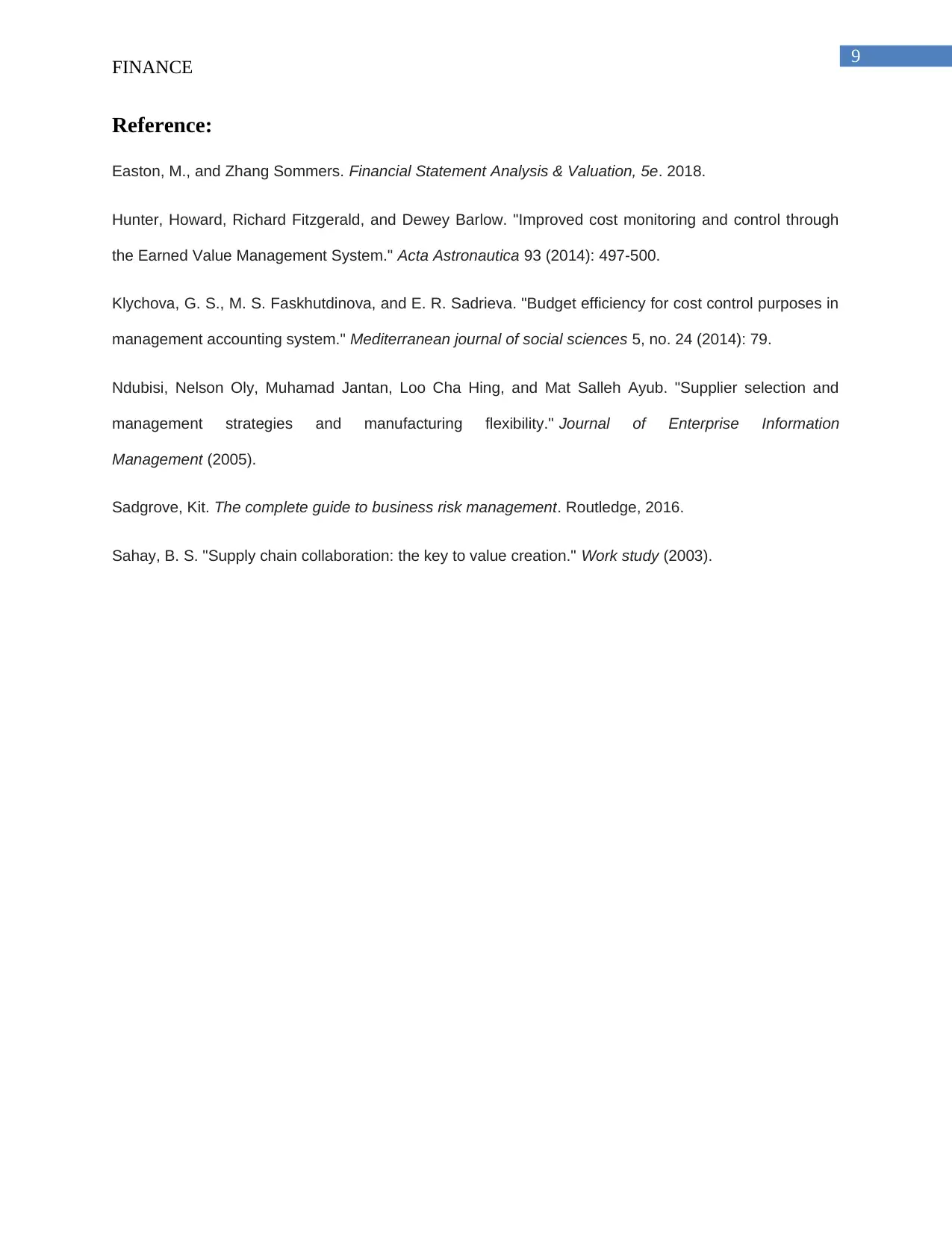
9
FINANCE
Reference:
Easton, M., and Zhang Sommers. Financial Statement Analysis & Valuation, 5e. 2018.
Hunter, Howard, Richard Fitzgerald, and Dewey Barlow. "Improved cost monitoring and control through
the Earned Value Management System." Acta Astronautica 93 (2014): 497-500.
Klychova, G. S., М. S. Faskhutdinova, and E. R. Sadrieva. "Budget efficiency for cost control purposes in
management accounting system." Mediterranean journal of social sciences 5, no. 24 (2014): 79.
Ndubisi, Nelson Oly, Muhamad Jantan, Loo Cha Hing, and Mat Salleh Ayub. "Supplier selection and
management strategies and manufacturing flexibility." Journal of Enterprise Information
Management (2005).
Sadgrove, Kit. The complete guide to business risk management. Routledge, 2016.
Sahay, B. S. "Supply chain collaboration: the key to value creation." Work study (2003).
FINANCE
Reference:
Easton, M., and Zhang Sommers. Financial Statement Analysis & Valuation, 5e. 2018.
Hunter, Howard, Richard Fitzgerald, and Dewey Barlow. "Improved cost monitoring and control through
the Earned Value Management System." Acta Astronautica 93 (2014): 497-500.
Klychova, G. S., М. S. Faskhutdinova, and E. R. Sadrieva. "Budget efficiency for cost control purposes in
management accounting system." Mediterranean journal of social sciences 5, no. 24 (2014): 79.
Ndubisi, Nelson Oly, Muhamad Jantan, Loo Cha Hing, and Mat Salleh Ayub. "Supplier selection and
management strategies and manufacturing flexibility." Journal of Enterprise Information
Management (2005).
Sadgrove, Kit. The complete guide to business risk management. Routledge, 2016.
Sahay, B. S. "Supply chain collaboration: the key to value creation." Work study (2003).
1 out of 10
Related Documents
Your All-in-One AI-Powered Toolkit for Academic Success.
+13062052269
info@desklib.com
Available 24*7 on WhatsApp / Email
![[object Object]](/_next/static/media/star-bottom.7253800d.svg)
Unlock your academic potential
Copyright © 2020–2025 A2Z Services. All Rights Reserved. Developed and managed by ZUCOL.




